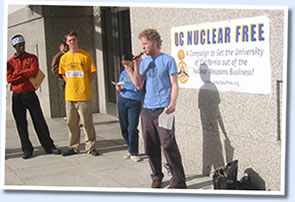
main_image2.jpgn19vt6.jpg, image/jpeg, 295x202
Over the past several decades students and faculty of the University of California, often in tandem with nuclear disarmament NGOs in California and New Mexico, have conducted a series of campaigns to end the UC's involvement in nuclear weapons research, design, testing, and production at the Los Alamos and Lawrence Livermore laboratories. These campaigns represent an important contribution to the global nuclear abolition movement, which historian Lawrence Wittner has described as "the largest, most dynamic international citizens' movement of modern times."

main_image2.jpgn19vt6.jpg, image/jpeg, 295x202
A new, comprehensive resource for information on the University of California's role in the design, research, testing, and production -- every nuclear weapon in the US arsenal was designed by a UC employee! -- is now online. The Web site, ucnuclearfree.org, is intended to give students, faculty, staff, and community members a clearinghouse of information to strengthen their efforts in trying to sever university involvement in the production and maintenance of weapons of mass destruction.
The issue of UC weapons lab management has become especially timely in recent months. Within the next two weeks, the Department of Energy is expected to select a new contractor to "manage" to the Los Alamos National Laboratory (LANL), the legendary facility responsible for 80 percent of the nuclear weapons designs in the US arsenal. Once managed exclusively by the University of California, the LANL management contract was put up for a competitive bid this past May.
Two conglomerates are vying for the contract, one led by the University of California and Bechtel Corporation; the other, by the University of Texas and Lockheed Martin.
The other weapons lab managed by the UC, Lawrence Livermore National Laboratory, will remain under the UC's auspices until at least 2007.
The feature below is taken from ucnuclearfree.org's Features section...
A People's History of UC Weapons Lab Mangement
Over the past several decades students and faculty of the University of California, often in tandem with nuclear disarmament NGOs in California and New Mexico, have conducted a series of campaigns to end the UC's involvement in nuclear weapons research, design, testing, and production at the Los Alamos and Lawrence Livermore laboratories. These campaigns represent an important contribution to the global nuclear abolition movement, which historian Lawrence Wittner has described as “the largest, most dynamic international citizens' movement of modern times.”
This larger disarmament movement has always formed the context for these grassroots efforts to disassociate the UC with the labs. When the global nuclear abolition movement was at its pinnacle in the 1980s, the UC-labs severance movement likewise peaked, with literally thousands of students and faculty members participating in various rallies, sit-ins, petition drives, and other forms of (often highly-creative) protest. When the disarmament movement dwindled in the ‘90s, the UC severance movement fell from the radar of most students and other would-be disarmament activists.
Today, the UC severance movement is again on the rise, enlivened by a new generation of student activists who have injected it with a fresh analysis of how the campaign's goals might be achieved. This overview of the history of the UC's ties to the labs, written from the perspective of people who have mobilized to oppose it, aims to provide current UC peace activists with crucial insights to inform their efforts.
Los Alamos: "Born at the Crosshairs"
The first national nuclear weapons laboratory was built in 1943 in the high desert of Los Alamos, New Mexico, near where “the boundaries of Colorado, Utah, Arizona, and New Mexico intersect like the crosshairs of a gunsight” (in the words of Grey Brechin, author of Imperial San Francisco: Urban Power, Earthly Ruin). Due to the involvement of UC scientists, the UC Regents agreed to manage the lab, in partnership with the federal government. The lab’s location in Los Alamos was specifically requested by UC Berkeley scientist and “Manhattan Project” leader J. Robert Oppenheimer.
According to the standard historical record, most UC officials initially did not intend for the Los Alamos management contract to stay in their camp after the completion of the “Manhattan Project.” UC Treasurer Robert Underhill inserted a clause in the original contract whereby the UC would severe ties to the labs within 90 days after the end of World War II. After the atomic bombs were dropped on Hiroshima and Nagasaki and the UC’s role in their creation became publicly known, many UC Regents and administrators argued for this clause to be exercised with all due haste.
But powerful forces within the UC scientific community and the university upper-administration strongly favored maintaining, formalizing, and even expanding the relationship. The Regents voted to sign a series of short-term contract extensions with the Atomic Energy Commission (AEC – later the Department of Energy) from 1945-47. At that point, UC scientist Ernesto Lawrence (the other half of the famous Lawrence-Oppenheimer “Manhatten Project” tandem) successfully pressed the Regents to agree to a multi-year contract extension with the AEC.
The Soviet Union’s first nuclear test in 1949 gave Lawrence the pretext to pursue his next bold move: lobbying the federal government to create a second nuclear weapons facility, this time in Livermore. The new lab was to be built ostensibly for the purpose of creating a fusion bomb. Influential University of Chicago physicist Edward Teller and other allies of Lawrence also lobbied heavily for the construction of the new facility. President Harry S. Truman approved the idea in relatively short order, and the “Livermore Site” of the UC Radiation Lab (now the Lawrence Livermore National Laboratory) was completed in 1952, initially as a branch of the Berkley Radiation Lab at UC Berkeley.